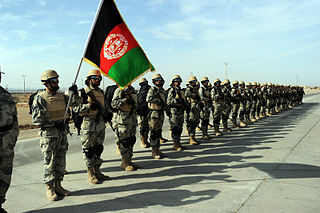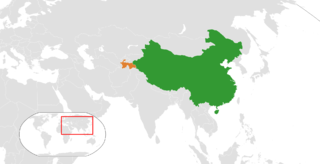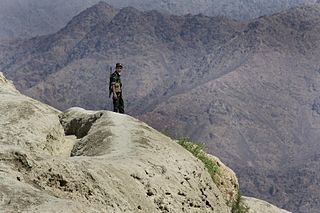Related Research Articles

Tajikistan, officially the Republic of Tajikistan, is a landlocked country in Central Asia. It has an area of 142,326 km2 (54,952 sq mi) and an estimated population of 9,750,065 people. Dushanbe is the country's capital and largest city. It is bordered by Afghanistan to the south, Uzbekistan to the west, Kyrgyzstan to the north, and China to the east. It is separated narrowly from Pakistan by Afghanistan's Wakhan Corridor. Tajiks form the ethnic majority in the country and their national language is Tajik, a variety of Persian that is closely related to the mutually intelligible dialects of Farsi and Dari in Iran and Afghanistan.

The Armed Forces of the Republic of Tajikistan, also known as the Tajik National Army is the national military of the Republic of Tajikistan. It consists of Ground Forces, Mobile Forces, and the Air Force, with closely affiliated forces including the national guard, border and internal troops.

The Tajik Soviet Socialist Republic, also commonly known as Soviet Tajikistan, the Tajik SSR, or simply Tajikistan, was one of the constituent republics of the Soviet Union which existed from 1929 to 1991 located in Central Asia.

Gorno-Badakhshan, officially the Badakhshan Mountainous Autonomous Region, is an autonomous region in eastern Tajikistan, in the Pamir Mountains. It makes up nearly forty-five percent of the country's land area but only two percent of its population.
This following is a list of public holidays in Tajikistan:
Shib Koh is a district in Farah Province, Afghanistan which borders Iran. Its population, which is 50% Pashtun and 45% Tajik, along with other ethnic groups, was estimated at 328,000 in January 2005. The district fell to the Taliban on 12 December 2018, after Afghan troops withdrew.

The Soviet Border Troops were the border guard of the Soviet Union, subordinated to the Soviet state security agency: first to the Cheka/OGPU, then to NKVD/MGB and, finally, to the KGB. Accordingly, they were known as NKVD Border Security and KGB Border Troops. Unlike the border guards of many other countries, Soviet Border Troops also included the maritime border guarding units, and aviation units.

Rudaki District is a district in Tajikistan, one of the Districts of Republican Subordination. It stretches south from Dushanbe, bordering on Shahrinav District, the city of Hisor, and Varzob District from the north and northwest, Tajikistan's Khatlon Region from the south and the east, and Uzbekistan from the west. Its administrative capital is Somoniyon, a southern suburb of Dushanbe, called Leninsky in the Soviet period. The population of the district is 518,200.
Khan Abad District is situated in the eastern part of Kunduz Province, Afghanistan. It borders Kunduz District to the west, Archi District to the northeast, Takhar Province to the east and Ali abad District to the south. The population is 140,600 (2006): 40% Pashtun, 20% Hazara, 25% Tajik, 10% Uzbek and 5% Pashai. The district center is the town of Khan Abad, located in the central part of the district.

The Afghan Border Force (ABF) was responsible for security of Afghanistan's border area with neighboring countries extending up to 30 miles (48 km) into the interior and formed part of the Afghan National Army. In December 2017, most of the Afghan Border Police (ABP) personnel of the Afghan National Police were transferred to the Afghan National Army to form the Afghan Border Force. The ABP retained 4,000 personnel for customs operations at border crossings and international airports such as checking documents of foreigners entering the country or deporting them.

The People's Republic of China and the Republic of Tajikistan have friendly relations characterized by bilateral and multilateral collaboration.

The Tajik Ground Forces, known officially as the Ground Forces of the Ministry of Defense of Tajikistan are the land forces of the Armed Forces of the Republic of Tajikistan. Formed during the Tajik Civil War, it makes up about 70 percent of the country's Armed Forces.

The Border Troops, also called the Border Service, is the border guard of Tajikistan. Functioning under the State Committee for National Security as part of the Armed Forces, the border guards are trained by the Organization for Security and Co-operation in Europe, along with the Afghan Border Police. A higher education college is located in the capital, Dushanbe, the Border Troops Academy, and a Border Troops Training Centre is located south of it, in the Rudaki District. The main control station of the border troops is the Border Management Center of the Main Border Guard Directorate of the SCNS.
The Border Troops Academy or Tajik Frontier Institute, officially known as the Higher Border Institute of the State Committee for National Security, is a higher education college for training of officers for the Tajik Border Troops, located in Dushanbe, the capital of Tajikistan. It is a state institution.

The Mobile Forces are the paratroopers of the armed forces of Tajikistan. They are similar to the Russian Airborne Troops, whom they often train with. The Mobile Forces act as an elite special forces unit, subservient to the Defense Ministry and separate from the ground forces. Although they are called paratroopers, the Mobile Forces often deployed out of helicopters, as the Tajik Air Force has few fixed wing aircraft.

A three-day border conflict between Kyrgyzstan and Tajikistan began on 28 April 2021. The clashes stemmed from a long-running dispute over a water supply facility near the village of Kök-Tash. Tajik media raised some concern over military drills in Batken prior to the conflict.
This is a list of individuals and events related to Kyrgyzstan in 2022.

A series of sporadic border clashes resumed between Kyrgyzstan and Tajikistan on 27 January 2022, following a series of clashes in 2021 between the two countries. These events took place before and during Russia's invasion of Ukraine that began a month before the second clashes.
This is a list of individuals and events related to Tajikistan in 2022.
The Red Banner Central Asian Border District was a district of the Soviet KGB Border Guards. It had its headquarters in Ashgabad. It guarded the Afghan-Soviet and the Iranian-Soviet border. The sea border of the district extended halfway along the southern line of Soviet territorial waters in the Caspian Sea until it met the terrain of the Red Banner Trans-Caucasus Border District.
References
- ↑ "Tajik border guards trained by OSCE". 30 November 2011. Retrieved 26 September 2013.